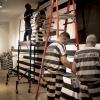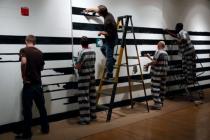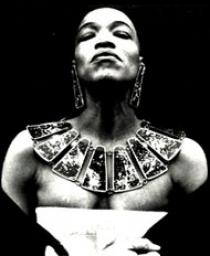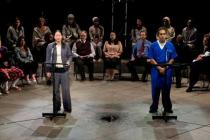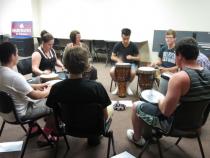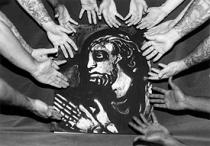Criminal Justice in the Arts
Today, the United States houses twenty-five percent of the world’s total prison population. America’s perception of criminality and corrections is deeply enmeshed within this current context of mass incarceration. Throughout the United States, art is being used to bring awareness to issues of mass incarceration, to engage incarcerated populations, or build community among those affected by the criminal justice system. These profiles reflect projects, artists, and organizations that are bringing awareness to the prison industrial complex in innovative and artistic ways.
|
It’s Not Just Black and White gave voice to the multiple constituents who are involved with the corrections, incarceration, and the criminal justice system. Artist Gregory Sale used the iconic black and white striped prison uniforms in Maricopa County, Arizona as a metaphor for the highly complex issue of mass incarceration; the intent of the project was to explore and expose the many and often conflicting viewpoints, perspectives, and values that are generated from serious considerations of justice and public safety. |
Rhodessa Jones is Co-Artistic Director of the San Francisco acclaimed performance company Cultural Odyssey. Jones is also the Founder and Director of the award winning Medea Project: Theater for Incarcerated Women, which is a performance workshop designed to achieve personal and social transformation with incarcerated women. |
|
|
Artist and activist Paul Rucker creates interdisciplinary art that infuses his music and composing talents with visual art. He has performed inside both active prisons and the notorious Alcatraz prison to prompt dialogue about mass incarceration and inhumane conditions. He believes by being as direct as performing inside the confines of the prison, he is being as active and verbal about the cause in the most direct and efficient manner. |
In its Justice Cycle Project, Cornerstone Theater Company created a series of six original community-based productions that examined the complex ways laws shape and disrupt communities in Los Angeles. Immediately following each performance, audience members were invited to join in dialogue with Los Angeles’s civic and cultural leaders to discuss urgent issues of justice in the city and beyond. The four-year project began with Los Illegals, a bilingual play by Michael John Garcés that explored the issue of undocumented immigration. |
Nick Szuberla is an artist at Appalshop, an Appalachian-based arts organization. In 1998, Nick founded the media arts project "Holler to the Hood" to explore the social impact of moving hundreds of thousands of inner city minority offenders to distant rural prisons. With a variety of media (live performance, radio, video and digital) and forms (including a multimedia installation and database-driven web site), his projects focus on creating public space where people can tell their story in their own voice. |
|
Reconnecting, a new musical composition for full orchestra and drum circle, was conceived and developed by composer Ben Goldberg and Central Ohio Symphony Executive Director Warren Hyer to create a musical dialogue about a unique local rehabilitation program for juvenile offenders with mental illness or substance abuse issues. The piece will be a single movement work of approximately 10 to 15 minutes, to be premiered during the Symphony’s 2014-15 concert season. |
Shakespeare Behind Bars is a Louisville, Kentucky based project focusing on the aspects of theatre that can make a person trust, collaborate, critically think, have a desire to help others and create a positive self image. The program has been a success since 1995 and it has since sparked a documentary film about the intimate's journey through the theatrical process. The documentary was by Philomath Films, an organization that supports social change by helping to create documentaries on the people and programs helping communities. |
In 2008, ten years after Tamms CMAX Prison opened, human rights advocates started a program to help those incarcerated there to cope with the long-term and inhumane conditions. Tamms Year 10 is a project created by human rights activists that allows the public to get insight into the negative effects of extended solitary confinement, and how it directly correlates with the inability for inmates to react to rehabilitation tactics and creates poor mental health. Tamms Poerty and the Photo Request from Solidarity are both projects that use the arts to help connect those in confinement with the |
|
Focused on a transformative art experience in non-traditional settings, the William James Association has been a platform for change for incarcerated populations, troubled youth, and parolees. The association's website is a valuable tool with in-depth resources that show what the art community is doing for corrections awareness and reform. The association has been a huge contributor for funding assistance and creating and maintaining new projects to help spread awareness for criminal justice issues. It has been an intregal part of criminal justice reform and rehabilitation. |
Since 1977, the William James Association has been organizing the Prison Arts Project, a project funded by the San Francisco Foundation, the NEA, the California Arts Council and the Law Enforcement Assistance Administration. Its success has been because of their dedicated team of art advocates who promote art leading to a better self-image and worth. The prison system is a place of negative behavior, and does little to endorse a positive life after release. Because the Prison Arts Project is so far-reaching, it has had the chance to impact large number of now-free inmates. |
A Day at Stateville is a play detailing newcomer’s first day at Stateville Correctional Facility in Joliet, Illinois. The play was conceived and written by inmates who took the prison’s “Life Transformation Through Communication” course, all of whom have life sentences without parole. It seeks to inspire community members to take action to reduce the number of at-risk youth entering prisons, and to advocate for the improvement of prison conditions. Former prisoners throughout Chicago perform the play in the form of a theatrical reading. |
|
As a vital member of the Detroit community, 4TheatrSake seeks to promote social change, particularly in the criminal justice system. Their production Cells/$hips was a viral sensation as it created discussion for the lifestyles of the incarcerated. |
The Prison Creative Arts Project (PCAP) was founded in 1990 to collaborate with incarcerated adults, incarcerated youth, urban youth and the formerly incarcerated to strengthen community through creative expression. Housed in the University of Michigan’s Residential College, faculty and students have worked for over twenty years with community members, both in and outside prisons, to engage in workshops in theatre, dance, visual art, creative writing, slam poetry, and music. |
